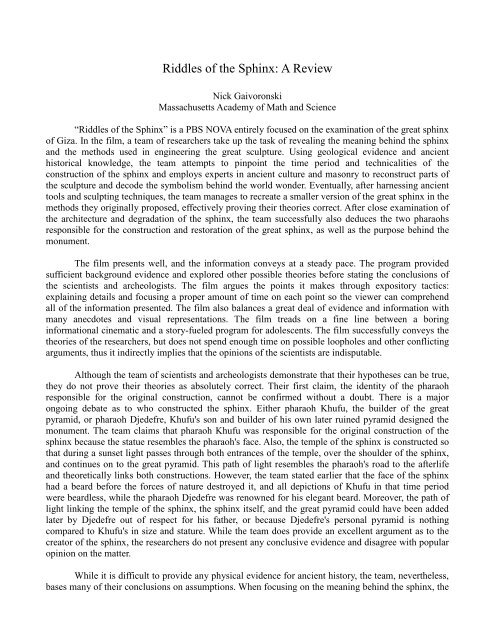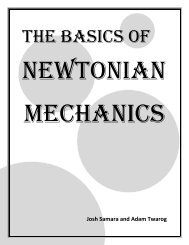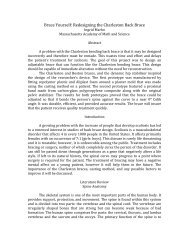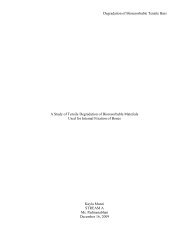Riddles of the Sphinx: A Review - the Scientia Review
Riddles of the Sphinx: A Review - the Scientia Review
Riddles of the Sphinx: A Review - the Scientia Review
Create successful ePaper yourself
Turn your PDF publications into a flip-book with our unique Google optimized e-Paper software.
<strong>Riddles</strong> <strong>of</strong> <strong>the</strong> <strong>Sphinx</strong>: A <strong>Review</strong><br />
Nick Gaivoronski<br />
Massachusetts Academy <strong>of</strong> Math and Science<br />
“<strong>Riddles</strong> <strong>of</strong> <strong>the</strong> <strong>Sphinx</strong>” is a PBS NOVA entirely focused on <strong>the</strong> examination <strong>of</strong> <strong>the</strong> great sphinx<br />
<strong>of</strong> Giza. In <strong>the</strong> film, a team <strong>of</strong> researchers take up <strong>the</strong> task <strong>of</strong> revealing <strong>the</strong> meaning behind <strong>the</strong> sphinx<br />
and <strong>the</strong> methods used in engineering <strong>the</strong> great sculpture. Using geological evidence and ancient<br />
historical knowledge, <strong>the</strong> team attempts to pinpoint <strong>the</strong> time period and technicalities <strong>of</strong> <strong>the</strong><br />
construction <strong>of</strong> <strong>the</strong> sphinx and employs experts in ancient culture and masonry to reconstruct parts <strong>of</strong><br />
<strong>the</strong> sculpture and decode <strong>the</strong> symbolism behind <strong>the</strong> world wonder. Eventually, after harnessing ancient<br />
tools and sculpting techniques, <strong>the</strong> team manages to recreate a smaller version <strong>of</strong> <strong>the</strong> great sphinx in <strong>the</strong><br />
methods <strong>the</strong>y originally proposed, effectively proving <strong>the</strong>ir <strong>the</strong>ories correct. After close examination <strong>of</strong><br />
<strong>the</strong> architecture and degradation <strong>of</strong> <strong>the</strong> sphinx, <strong>the</strong> team successfully also deduces <strong>the</strong> two pharaohs<br />
responsible for <strong>the</strong> construction and restoration <strong>of</strong> <strong>the</strong> great sphinx, as well as <strong>the</strong> purpose behind <strong>the</strong><br />
monument.<br />
The film presents well, and <strong>the</strong> information conveys at a steady pace. The program provided<br />
sufficient background evidence and explored o<strong>the</strong>r possible <strong>the</strong>ories before stating <strong>the</strong> conclusions <strong>of</strong><br />
<strong>the</strong> scientists and archeologists. The film argues <strong>the</strong> points it makes through expository tactics:<br />
explaining details and focusing a proper amount <strong>of</strong> time on each point so <strong>the</strong> viewer can comprehend<br />
all <strong>of</strong> <strong>the</strong> information presented. The film also balances a great deal <strong>of</strong> evidence and information with<br />
many anecdotes and visual representations. The film treads on a fine line between a boring<br />
informational cinematic and a story-fueled program for adolescents. The film successfully conveys <strong>the</strong><br />
<strong>the</strong>ories <strong>of</strong> <strong>the</strong> researchers, but does not spend enough time on possible loopholes and o<strong>the</strong>r conflicting<br />
arguments, thus it indirectly implies that <strong>the</strong> opinions <strong>of</strong> <strong>the</strong> scientists are indisputable.<br />
Although <strong>the</strong> team <strong>of</strong> scientists and archeologists demonstrate that <strong>the</strong>ir hypo<strong>the</strong>ses can be true,<br />
<strong>the</strong>y do not prove <strong>the</strong>ir <strong>the</strong>ories as absolutely correct. Their first claim, <strong>the</strong> identity <strong>of</strong> <strong>the</strong> pharaoh<br />
responsible for <strong>the</strong> original construction, cannot be confirmed without a doubt. There is a major<br />
ongoing debate as to who constructed <strong>the</strong> sphinx. Ei<strong>the</strong>r pharaoh Khufu, <strong>the</strong> builder <strong>of</strong> <strong>the</strong> great<br />
pyramid, or pharaoh Djedefre, Khufu's son and builder <strong>of</strong> his own later ruined pyramid designed <strong>the</strong><br />
monument. The team claims that pharaoh Khufu was responsible for <strong>the</strong> original construction <strong>of</strong> <strong>the</strong><br />
sphinx because <strong>the</strong> statue resembles <strong>the</strong> pharaoh's face. Also, <strong>the</strong> temple <strong>of</strong> <strong>the</strong> sphinx is constructed so<br />
that during a sunset light passes through both entrances <strong>of</strong> <strong>the</strong> temple, over <strong>the</strong> shoulder <strong>of</strong> <strong>the</strong> sphinx,<br />
and continues on to <strong>the</strong> great pyramid. This path <strong>of</strong> light resembles <strong>the</strong> pharaoh's road to <strong>the</strong> afterlife<br />
and <strong>the</strong>oretically links both constructions. However, <strong>the</strong> team stated earlier that <strong>the</strong> face <strong>of</strong> <strong>the</strong> sphinx<br />
had a beard before <strong>the</strong> forces <strong>of</strong> nature destroyed it, and all depictions <strong>of</strong> Khufu in that time period<br />
were beardless, while <strong>the</strong> pharaoh Djedefre was renowned for his elegant beard. Moreover, <strong>the</strong> path <strong>of</strong><br />
light linking <strong>the</strong> temple <strong>of</strong> <strong>the</strong> sphinx, <strong>the</strong> sphinx itself, and <strong>the</strong> great pyramid could have been added<br />
later by Djedefre out <strong>of</strong> respect for his fa<strong>the</strong>r, or because Djedefre's personal pyramid is nothing<br />
compared to Khufu's in size and stature. While <strong>the</strong> team does provide an excellent argument as to <strong>the</strong><br />
creator <strong>of</strong> <strong>the</strong> sphinx, <strong>the</strong> researchers do not present any conclusive evidence and disagree with popular<br />
opinion on <strong>the</strong> matter.<br />
While it is difficult to provide any physical evidence for ancient history, <strong>the</strong> team, never<strong>the</strong>less,<br />
bases many <strong>of</strong> <strong>the</strong>ir conclusions on assumptions. When focusing on <strong>the</strong> meaning behind <strong>the</strong> sphinx, <strong>the</strong>
team <strong>of</strong> scientists and archeologists claim that <strong>the</strong> sphinx was originally meant to represent <strong>the</strong> power<br />
and glory <strong>of</strong> <strong>the</strong> pharaoh who ordered <strong>the</strong> initial construction, and as <strong>the</strong> deity which governs and<br />
protects <strong>the</strong> pharaoh's journey to <strong>the</strong> afterlife after <strong>the</strong> reconstruction effort 1000 years after <strong>the</strong> sphinx<br />
was abandoned. However, <strong>the</strong>se <strong>the</strong>ories are shaky at best in terms <strong>of</strong> accuracy, and <strong>the</strong>y should not be<br />
accepted for absolute truth. While <strong>the</strong> scientists say that <strong>the</strong> sphinx was originally meant to resemble<br />
<strong>the</strong> assumed builder <strong>of</strong> <strong>the</strong> statue, pharaoh Khufu, this contradicts <strong>the</strong> earlier evidence <strong>of</strong> light cast<br />
through <strong>the</strong> temple <strong>of</strong> <strong>the</strong> sphinx creating a pathway to <strong>the</strong> afterlife because <strong>the</strong>n <strong>the</strong> sphinx would be<br />
partially standing in <strong>the</strong> way <strong>of</strong> path, thus resembling a guardian. Therefore, <strong>the</strong> sphinx is not<br />
necessarily Khufu or Djedefre but perhaps a guardian built in <strong>the</strong>ir image simply to please <strong>the</strong>m. Also,<br />
while <strong>the</strong> team is most likely correct in <strong>the</strong>ir <strong>the</strong>ories regarding <strong>the</strong> construction <strong>of</strong> <strong>the</strong> main body <strong>of</strong> <strong>the</strong><br />
sphinx: <strong>the</strong>ir claim that <strong>the</strong> body was dug out <strong>of</strong> limestone, <strong>the</strong>ir hypo<strong>the</strong>sis concerning <strong>the</strong> origin <strong>of</strong> <strong>the</strong><br />
head is very disputable. The team claims that <strong>the</strong> sphinx was dug out next to a rock protruding out <strong>of</strong><br />
<strong>the</strong> surface which would later become <strong>the</strong> head <strong>of</strong> <strong>the</strong> sphinx.<br />
Although <strong>the</strong> team has insurmountable geological evidence for <strong>the</strong>ir first <strong>the</strong>ory, <strong>the</strong>ir second<br />
claim would only be valid if <strong>the</strong> sphinx was not placed as exactly as it was in relation to <strong>the</strong> temple.<br />
The pathway <strong>of</strong> light from <strong>the</strong> temple <strong>of</strong> <strong>the</strong> sphinx, across <strong>the</strong> shoulder <strong>of</strong> <strong>the</strong> sphinx, and strait to <strong>the</strong><br />
great pyramid <strong>of</strong> Giza is too accurate to be coincidental. The argument behind this could be that <strong>the</strong><br />
sphinx was built before <strong>the</strong> pyramid, but this would not make any sense because <strong>the</strong> sphinx was<br />
intended to be ei<strong>the</strong>r a guardian for <strong>the</strong> pathway to <strong>the</strong> underworld or a sculpture promoting <strong>the</strong><br />
pharaoh's power. However, <strong>the</strong> latter would only be built after <strong>the</strong> pyramid and would not be a very<br />
effective sculpture to <strong>the</strong> greatness <strong>of</strong> <strong>the</strong> pharaoh if it was so far away from <strong>the</strong> city <strong>of</strong> Giza. The<br />
building <strong>of</strong> both projects simultaneously would also be improbable because <strong>the</strong> amount <strong>of</strong> manpower to<br />
build both marvels <strong>of</strong> architecture at <strong>the</strong> same time would be too much because <strong>of</strong> all <strong>of</strong> <strong>the</strong> people<br />
required to make and maintain tools while carving and digging and carrying blocks up <strong>the</strong> pyramid.<br />
The team <strong>of</strong> scientists and archeologists did a good job in explaining <strong>the</strong> way in which <strong>the</strong> sphinx was<br />
built and roughly pinpointing <strong>the</strong> time and length <strong>of</strong> <strong>the</strong> construction and restoration <strong>of</strong> <strong>the</strong> sphinx, but<br />
<strong>the</strong>y were nearsighted in some <strong>of</strong> <strong>the</strong>ir claims.<br />
The film “<strong>Riddles</strong> <strong>of</strong> <strong>the</strong> <strong>Sphinx</strong>”, which originally aired on September 27 th , 2008, is an<br />
informative and well presented NOVA focusing on dismantling <strong>the</strong> mysteries <strong>of</strong> <strong>the</strong> sphinx. The film is<br />
well paced and provides sufficient evidence for most <strong>of</strong> <strong>the</strong> <strong>the</strong>ories <strong>of</strong> <strong>the</strong> scientists while not losing<br />
<strong>the</strong> audience's attention. The film is able to draw a clear and vivid picture <strong>of</strong> <strong>the</strong> construction and<br />
purpose as well as <strong>the</strong> time period <strong>of</strong> <strong>the</strong> great sphinx for <strong>the</strong> viewer in a little more than fifty minutes.<br />
However, even though <strong>the</strong> film conveys a multitude <strong>of</strong> evidence in support <strong>of</strong> <strong>the</strong> claims made by <strong>the</strong><br />
team <strong>of</strong> scientists, it does not focus enough on ulterior <strong>the</strong>ories and loopholes in <strong>the</strong> arguments <strong>of</strong> <strong>the</strong><br />
team, such as <strong>the</strong> possibility <strong>of</strong> <strong>the</strong> sphinx originally intended to be a guardian <strong>of</strong> <strong>the</strong> underworld. I<br />
enjoyed <strong>the</strong> “<strong>Riddles</strong> <strong>of</strong> <strong>the</strong> <strong>Sphinx</strong>” (http://www.sidereel.com/NOVA/season-37/episode-11) NOVA<br />
very much and give it a rating <strong>of</strong> four stars out <strong>of</strong> five.
















